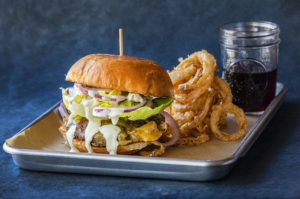As bacon gives over its 15 minutes of fame to the Next Big Thing in Food, waiting in the wings are heirloom beans and ancient grains the humblest of peasant foods ready for their moment in the spotlight.
Its really an everything old is new again story, because grains and beans, which together make up the basis for a civilization-sustaining diet, have been feeding us for tens of thousands of years. From Asia to the Americas, nearly every culture has combined the two: soybeans and rice in Asia, millet and lentils in the Africas; quinoa, amaranth, rice and a rainbow of beans in the Americas.
Life-sustaining and healthy, these staple foods are high in fiber and protein, often containing minerals and vitamins lacking in a processed food diet. With increasing numbers of Americans looking at flexitarian or part-time vegetarian diets to lose weight and boost longevity, these long-forgotten flavors are making their way back into our diets.
With many local advocates from the Slow Food movement, as well as heirloom seed savers, forward-thinking farmers and local importers, a variety of beans and grains have deep roots in Sonoma and Napa.
Two recent cookbooks, San Franciscan Heidi Swanson’s Super Natural Every Day: Well-loved Recipes from My Natural Foods Kitchen and Maria Speck’s Ancient Grains for Modern Meals
along with Steve Sandos 2009 Heirloom Beans
bring the ancient foods trend to modern kitchens with dishes like millet muffins or lentil soup with brown butter and coconut milk.
Here’s how to get started…
 Heirloom beans: With creative and curious names like Tigers Eye, Good Mother, Jacobs Cattle and Black Turtle, these arent your average supermarket pintos. Local farmers like Tierra Vegetables and Bernier Farms are offering up dried beans at farm markets. Tierra, in fact, offers more than 20 at their Windsor farm stand. Another incredible regional resource is Rancho Gordo in Napa. Steve Sando has almost single-handedly revived interest in small-batch native beans from Mexico. Working with indigenous farmers, he imports truckloads of exotic beans to high-end groceries, selling locally at Jimtown Store (6706 California 128, Healdsburg, 433-1212), Epicurean Connection (18816 Sonoma Hwy, Ste C, Sonoma, 935-7960) and from his storefront in Napa (1924 Yajome St., Napa, 259-1935).
Heirloom beans: With creative and curious names like Tigers Eye, Good Mother, Jacobs Cattle and Black Turtle, these arent your average supermarket pintos. Local farmers like Tierra Vegetables and Bernier Farms are offering up dried beans at farm markets. Tierra, in fact, offers more than 20 at their Windsor farm stand. Another incredible regional resource is Rancho Gordo in Napa. Steve Sando has almost single-handedly revived interest in small-batch native beans from Mexico. Working with indigenous farmers, he imports truckloads of exotic beans to high-end groceries, selling locally at Jimtown Store (6706 California 128, Healdsburg, 433-1212), Epicurean Connection (18816 Sonoma Hwy, Ste C, Sonoma, 935-7960) and from his storefront in Napa (1924 Yajome St., Napa, 259-1935).
Resources
Rancho Gordo: 1924 Yajome St, Napa, 259-1935
Tierra Vegetables: 651 Airport Boulevard, Santa Rosa, 837-8366
Bernier Farms: 1720 Canyon Road, Geyserville, 849.7592
Beans to check out
Petaluma Gold Rush: For more than 150 years, the Azevedo family has been growing this Peruvian native in Petaluma. According to Tierra Vegetables, this bean was initially grown and marketed in San Francisco during the 1840 when Azevedo jumped ship from a whaler to start his own ranch. With a meaty, creamy texture and pronounced flavor, these are great meat alternatives.
Flageolet: A favorite of French chef Escoffier, these meaty beans are often used in French country cuisine, most notably cassoulets.
 Black Turtle: Native to the Americas, these shiny black beans have an earthy quality and are often found in Mexican or Cajun cooking.
Black Turtle: Native to the Americas, these shiny black beans have an earthy quality and are often found in Mexican or Cajun cooking.
Yellow Eye: Dense and creamy, these beans are a top Rancho Gordo seller, with their butterscotch-colored spots.
Lentils: Available in a variety of colors these small beans are high in amino acids and cook more quickly than larger beans. Well known in Biblical times, these Middle Eastern natives are often used for soups, stews and porridges, but are equally delicious in cold salads.
Fagioli Badda: A traditional Italian bean used for pasta e fagioli sold by Bernier Farms.

Ancient Grains: Before white bread and rice, there were the rich, earthy, nutty and fibrous grains of our ancestors. Many are being re-introduced, especially with the rise of gluten-free diets, as alternatives to wheat. Although some are not actual grains (like quinoa, which is part of the goosefoot family) they are treated as such. Many of these grains can be found in bulk at high-end grocers or from producers like Anson Mills or Bobs Redmill.
Millet: Best known in the US as bird feed, millet is one of the most ancient grains known to man, cultivated and eaten for the last 10,000 years. In China, archeologists have found 4,000 year old noodles made with millet flour. Until the introduction of potatoes, it was very popular in European cooking as well. Gluten-free.
Quinoa: Native to the Americas, was revered by the Incas who called it the mother of all grains, according to Maria Speck in Ancient Grains for Modern Meals. Despite being more closely related to beets than wheat, quinoa has a fluffy, nutty texture and a slightly grassy taste. Gluten-free
Farro: A form of wheat, farro is native to the Fertile Crescent and has been found in Egyptian tombs. Chewy and firm, this grain cooks quickly and can be used in both sweet and savory dishes.
Amaranth: Gaining a lot of popularity is this superfood of the ancients. Loaded with amino acids, protein and minerals, the tiny seeds are often ground into flour, popped in Mexico and India or mixed into dishes to give a nutty, earthy flavor. Gluten-free.











